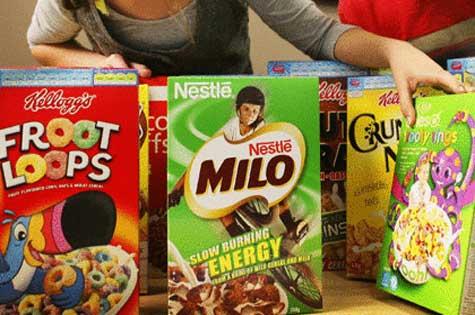In a review of 195 ready-to-eat cereals Choice found 73% of cereals marketed to children to be high in sugars. More than half of the kid’s cereals were low in fibre - most providing less than a gram per serve.
Aldi’s GoldenVale branded Honey Wheats, Choco Rice and Choco Pillows and Kellogg’s Frosties contain more than 40% sugar – the equivalent of three teaspoons per 30g serve.
“Whilst there have certainly been some nutritional improvements in breakfast cereals since our last review, too many still don’t deserve the healthy image that their marketing messages portray,” says Choice spokesperson, Ingrid Just.
Choice says that despite some cereal manufacturers delivering on a commitment to reduce salt levels in their products as members of the federal government’s Food and Health Dialogue, four of the eight saltiest cereals reviewed (containing at least 600mg sodium per 100g), are ones marketed to children.
“Kellogg’s has reduced the sodium levels in Cornflakes and Rice Bubbles by 20%, Sanitarium has reduced the sodium of Skippy Corn Flakes by 25% and Aldi’s Goldenvale Breakfast Bubbles has recently had a 30% reduction in its sodium content – yet surprisingly all four remain amongst the saltiest in our review,” says Ms Just.
For everyday eating CHOICE says the best cereals are those that are very high or high in fibre (or moderate fibre for kids) but don’t contain a lot of salt, sugar or saturated fat. ²
“All up we counted 36 out of the 195 reviewed that may be worth considering given their lower salt, suger and saturated fat levels with four standing out from the crowd nutritionally; Abundant Earth Puffed Corn, Uncle Tobys Shredded Wheat, Healtheries Pufferbillies and Sanitarium Weet-Bix for kids,” says Ms Just.
Australians spent 1.7 billion dollars on ready to eat cereals in 2011, the equivalent of 10 large 750g boxes for every adult and child.
CHOICE’s tips for finding a healthy breakfast cereal:
1. Make it a priority to choose cereals that are high in fibre.
2. Also look for cereals that have lower sugars, salt and saturated fat levels. In many cereals, dried fruits provide more than enough of the sugar content, without the need for added sweeteners.
3. Base your decision on the per 100g nutrition information on the packet rather than the marketing. Claims such as ‘99% fat free’, ‘no artificial colours or flavours’ and ‘contains wholegrain’ can mask high levels of other less desirable ingredients.

















__small.png)










